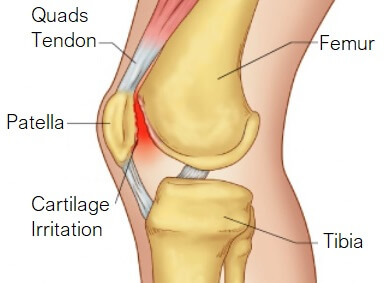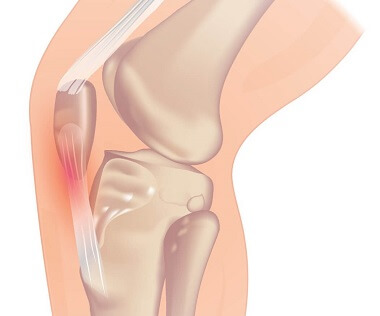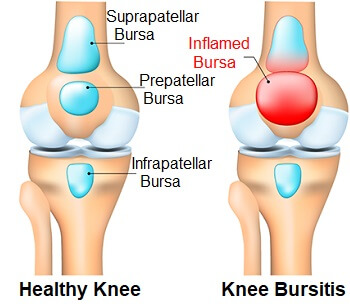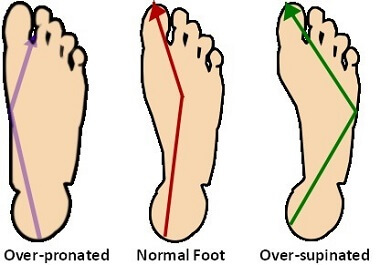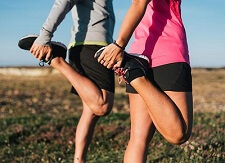- Home
- Knee Symptoms
- Running Knee Pain
Knee Pain From Running
Written By: Chloe Wilson, BSc(Hons) Physiotherapy
Reviewed by: KPE Medical Review Board
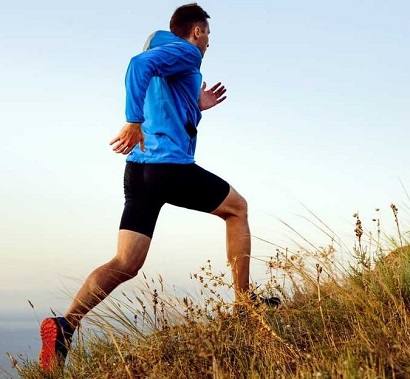
Knee pain from running is extremely common and can affect anyone from complete beginners to experienced runners.
Running is one of the most common activities for regular exercise.
It is a great way to improve fitness, lose weight, reduce stress, improve well-being and be healthy. It is cheap, doesn't require specialist equipment or instruction, and can be done whatever your fitness level.
But knee pain during or after a run is a common complaint. It is not really surprising when we think that forces up to 550% of your body weight go through the knee when you run.
Causes Of Knee Pain From Running
Here we are going to look at:
- Common causes of knee pain from running
- Why running causes knee problems
- How to avoid knee pain when running
- Common questions e.g. should you keep running with knee pain
Let's start by looking at the most common causes of knee pain from running.
1. Runners Knee
Runners Knee is the most common cause of knee pain from running, also known as patellofemoral pain syndrome or anterior knee pain.
In runners knee, there is a problem with how the kneecap moves, known as patellar maltracking.
This results in friction, wear and tear and irritation on the cartilage, resulting in front knee pain.
Common symptoms of runners knee included:
- Knee Pain: underneath the kneecap
- Aching Sensation: rather than a sharp pain
- Worse With Prolonged Activity: e.g. running or sports.
- Pain On Stairs: typically worse coming down
- Discomfort When Getting Up: in the morning or after sitting for a while
Runners knee may be caused by muscle imbalance or biomechanical problems at the foot, knee or hip.
Some people with runners knee find they get knee pain while running, whereas others only notice their knee pain after running.
Find out more about the causes, symptoms, diagnosis, and treatment options in the Runners Knee section.
2. Iliotibial Band Syndrome (ITBS)
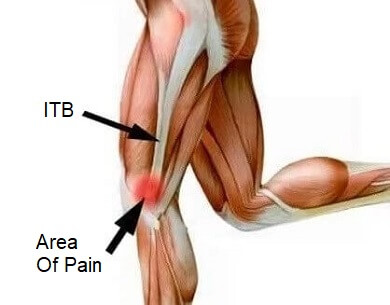
Iliotibial band syndrome is the most common cause of outer knee pain from running.
The iliotibial band is a thick band that runs down the outer side of the thigh between the hip and the knee.
If there is any tightness in the ITB it gets irritated and inflamed and causes friction on the underlying structures where it attaches to the knee.
With ITBS, the more you run, the more irritation there is at the knee and the more likely you are to get outer knee pain while running, or after running.
Common symptoms of iliotibial band syndrome include:
- Lateral Knee Pain: pain on the outer side of the knee
- Worse On Slopes: e.g. running up and down hills or on cambered roads
- Popping/Snapping Sensation: at the knee when you run
- Localised Swelling: on the outer side of the knee
Iliotibial band syndrome is one of the most common causes of knee pain from running in long distance runners.
You can find out all about how ITBS causes knee pain from running and how to treat it in the Iliotibial Band Syndrome section.
3. Patellar Tendonitis
Patellar tendonitis, aka Jumpers Knee, is another common cause of knee pain from running, usually causing pain just below the kneecap.
The patellar tendon is a thick band that connects the kneecap to the shin bone.
Repetitive overuse, e.g. from jumping or kicking sports, and muscle tightness causes tearing in the patellar tendon leading to irritation and inflammation.
Common symptoms of patellar tendonitis include:
- Pain Below The Kneecap: typically causes knee pain after running rather than during exercise
- Aching & Stiffness: in the knee after exercise or first thing in the morning
- Tenderness: to touch through the patellar tendon
- Thickening: of the tendon
Patellar tendonitis typically gets progressively worse over time so is more likely to affect seasoned runners rather than beginners. In the early stages you tend to get knee pain after running, but as it progresses you may start to notice knee pain while running.
You can find out more about why patellar tendonitis causes knee pain from running and how to treat it in the Jumpers Knee section.
4. Knee Bursitis
Another common causes of knee pain from running, often accompanied by some swelling, is knee bursitis.
The knee bursa are small fluid filled sacs found in various places around the knee that sit between bones and tendons to prevent friction.
The repetitive motion of running can cause excessive friction and pressure on one of the knee bursa resulting to irritation, inflammation and knee pain from running.
The symptoms of knee bursitis will vary depending on which
bursa is affected but typically include
- Knee Pain: at the affected bursa
- Knee Swelling: typically localised to the affected bursa rather than generalised knee swelling
- Knee Stiffness: pain and discomfort can restrict knee movement
Bursitis knee pain from running most often comes from prepatellar bursitis at the front of the knee or pes anserine bursitis on the inner side of the knee.
You can find out more about bursitis knee pain from running including the causes, symptoms and treatment options in the knee bursitis section.
Other Possible Causes
Other possible causes of knee pain from running include:
- Hamstring Tendinopathy: irritation of the hamstring tendons behind the knee which causes posterior knee pain from running. Typically caused by muscle imbalance so responds well to hamstring stretches and strengthening exercises
- Plica Syndrome: irritation and inflammation of the folds in the synovial lining of the knee joint. Plica syndrome often causes knee pain from running if you suddenly increase training levels
- Meniscus Tears: a tear in the cartilage that lines the knee joint. Most commonly affects the medial meniscus causing inner knee pain while running
- Ligament Sprains: overstretching or tearing of one of the knee ligaments can cause knee pain when running. The pain normally develops rapidly rather than gradually at the time of injury or within a few hours
Why Is It So Common?
So why is knee pain from running such a common problem? Around 75% cases of knee pain from running are due to chronic (long term) problems from overuse, often linked with muscle imbalance and altered biomechanics.
The other 25% of cases of knee pain from running are due to a one-off injuries.
Knee pain from running is generally caused by a combination of:
1. Training Errors
Poor training technique is a common cause of running knee pain. The most common mistakes people make are:
- Doing Too Much Too Soon: especially when you first start. It’s very easy to be over enthusiastic!
- Suddenly Increasing How Much You Do: e.g. distance, time and intensity. This is very common when training for an
event/competition
- Changing Your Running Style: e.g. changing running surface, adding in sprint sessions
or moving from flat to sloped surfaces
- Running Surface: ideally, you want to run on a smooth, soft, level surface. Running on tarmac or cambered roads (one
foot ends up being lower than the other) increases your chance of developing
knee pain from running
- Lack of Variety: if running is the only exercise you do, without any stretching, strengthening or other cardiovascular exercise, you are more likely to develop knee pain from running due to muscle imbalance and overuse
2. Biomechanical Problems
Knee pain from running is also often linked to problems with biomechanics, meaning how the different body parts move as we run. Foot position is extremely important but varies greatly from person to person.
People usually fall into one of five categories:
- Normal foot position
- Flat feet: no visible arch
- High arches
- Over-pronated: foot rolls inwards
- Over-supinated: foot rolls outwards
Ideally, when we walk or run, our heel hits the ground and then the weight is transferred to the middle of the foot and then to the toes. If you have poor biomechanics, it alters the way the forces are transferred through the feet and up the leg, making you prone to knee pain.
The most common foot problem is overpronation where the foot arch remains flat and the weight goes through the inside of the foot causing the ankle to roll in as you then push off.
This makes subtle but dramatic changes to how the forces go through the knee, putting more force through the kneecap and the inner side of the joint. If you oversupinate, which is a much less common problem, weight goes through the outer border of the foot.
It may be worth discussing this with your health care professional who can analyse your gait to identify any risk factors.
3. Muscle Imbalance
Muscle imbalance also affects the biomechanics throughout the leg and are common causes of running knee pain. There may be:
- Muscle Weakness: e.g. weak glutes can reduce your foot arch height. Strengthening exercises are a great way to reduce knee pain from running if there is any weakness in the muscles
- Muscle Tightness: e.g. tight quads can shift your kneecap slightly out of position. In the knee stretches section you'll find simple tests to see if muscle tightness is contributing to your knee pain from running and will find loads of exercises to stretch the different knee muscles.
How To Avoid Knee Pain Running
There are lots of things you can do to prevent knee pain from running:
1. Follow The 10% Rule
If you want to build up your training for whatever reason, it’s important to do it gradually otherwise you will almost certainly develop knee pain from running.
A good rule of thumb is the 10% rule where you increase your activity by up to 10% a week, be it the length of time you run for or the distance. For example, if you normally run 5 miles at a time, increase to up to 5.5 miles. After at least a week you can then increase by another 10%.
You may find that a 10% increase is too much initially, especially if you are just starting out or are returning to activity after an injury, in which case you might want to work at 5% increases instead. Listen to your body and do what is right for you and you shouldn’t suffer from running knee pain. The 10% rule is a guide, not a mantra!
2. Warm Up & Cool Down

Before and after exercise, make sure you are warming up and cooling down properly. A mixture of stretching, strengthening and cardiovascular exercise really helps to reduce knee pain from running.
You may be raring to go and warming up and cooling down correctly can seem tedious but it does make a difference and can help to reduce the risk of developing knee problems.
3. Use Good Footwear
Having the right support for your feet helps reduce biomechanical problems which in turn reduces the risk of running knee pain. Remember, everyone’s feet are different so try out lots of pairs of shoes and talk to a footwear expert to make sure the shoes you use have the right support in the right places for you.
Also, remember to change your shoes regularly. Over time, shoes stop providing good support and start to lose their shock absorbing properties. The general advice is to change your shoes after approximately 400-500 miles e.g. if you run 5 miles a day, 5 times a week, you should change your shoes every 3-4 months to prevent knee pain from running.
It can also help to have a couple of pairs of running shoes and alternate them.
4. Avoid Overtraining
Overtraining is a particularly common cause of knee pain from running when training for an event/competition. Overtraining is when you exercise beyond your body’s ability to recover. Our bodies need adequate rest and recovery time when we exercise, otherwise performance levels start to decrease.
Warning signs that you might be overtraining include fatigue, mood changes e.g. irritability and depression, decreased appetite, lack of enthusiasm for exercise, headaches, general aches and pains, drop in performance and insomnia.
5. Wear a Knee Support
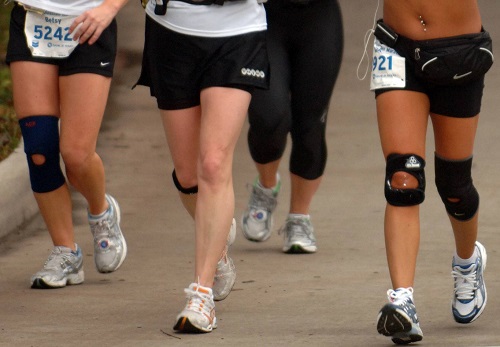
Ideally, if you have nice strong, flexible muscles, you shouldn’t need to wear a knee support when you run, but if you are getting knee pain from running, you might find a brace really helpful.
Knee braces and knee straps are particularly useful with conditions such as tendonitis or if there is any muscle weakness or imbalance.
If you do feel the need to wear a knee brace to try and reduce knee pain while running, I would recommend wearing one that has a hole at the front for the kneecap, as it provides support without putting pressure through the patella.
There are a whole range of options out there and in the knee brace section there is lots of advice about finding the right brace for you.
6. Vary Your Exercise
Running is a great way to keep fit, but if running is the only exercise you do, you are missing out. Ideally, you should do different types of exercise to work different muscle groups in different ways.
By doing a range of exercises, you will develop great overall strength (in your muscles, bones and cardiovascular system), flexibility, power, endurance, fitness, balance and co-ordination, as well as losing weight!
Good things to do as well as running include swimming, cycling, rowing, pilates, ball sports and strength training.
7. Use Ice
When used correctly, ice packs can really help to reduce inflammation and knee pain from running. They can be particularly useful if you are getting pain after running.
Visit the ice
therapy section to find out how to use it safely and effectively and the ice wraps section for the best ways to apply ice.
Running Knee Pain Questions
People often have lots of questions about knee pain from running so let's look at some of the most common ones:
What Causes Outer Knee Pain Running?
The most common cause of outer knee pain when running is iliotibial band syndrome - an overuse injury causing inflammation of the ITB. It can usually be self-treated with rest, ice, exercises and wearing a knee strap.
Outer knee pain from running can also be caused by iliotobial bursitis - inflammation of the bursa that sits between the ITB and the underlying bone. Or if the pain is at the back of the knee, it may be from biceps femoris tendonitis.
What Causes Inner Knee Pain After Running?
Inner knee pain when running may be a sign that you are overloading the cartilage on the inner side of the knee which can result in a meniscus injury. Altered foot biomechanics, decreased knee stability and poor glutes strength all affect the angle of the knee so more force goes through the inner side of the knee. There's generally a sharp pain that comes and goes.
Another possibility is pes anserine bursitis which causes inner knee pain about 2cm below the knee cap. Or if the pain is in the back of the knee it could be from semimembranosus or semitendinosus hamstring tendonitis.
What Causes Front Knee Pain When Running?
The most common cause of pain at the front of the knee when running is Runners Knee. It develops when there is excess friction on the back of the kneecap, usually due to a problem in how the kneecap moves as you run.
With Runners Knee there tends to be a general ache at the front of the knee and pain comes and goes, typically worse after prolonged activity or more surprisingly prolonged inactivity e.g. sitting for long periods.
Another possible cause of front knee pain when running is prepatellar bursitis which is usually accompanied by swelling at the knee cap. If the pain is just below the kneecap, it may be from infrapatellar bursitis. Again, there will usually be a pocket of swelling, this time below the kneecap.
What Causes Knee Pain After Running In Beginners?
If you've just taken up running and your knee is playing up, chances are you have overdone things. Suddenly increasing your activity levels places excess stress and strain on the soft tissues resulting in too much force going through the knee.
A combination of strengthening and stretching exercises, pacing and following a sensible training regime usually sorts it out.
Is It Normal For Knees To Hurt After Running?
Knee pain is certainly a common problem for runners, particularly those just starting out or those who have recently upped their training regime. It takes time for the body to adapt and develop the strength and endurance needed to cope with running.
It's the knees that take the brunt of the force when jogging so it's no surprise that knee pain running is a common problem. If the pain persists, gets worse as you run or doesn't settle when you rest, then you need to get it checked out as you may have an underlying knee injury.
Is Jogging Bad For Your Knees?
When done sensibly, running is a good, healthy thing to do. But don't jump straight in head first. It's about getting the right combination of
- Pacing: remember that 10% rule
- Good Footwear
- Good Body Condition: good muscle strength and length
- Having A Good Regime: including warming up and cooling down
- Thinking About Your Running Surface
- Listening To Your Body: don't just push on through
Knee pain from running certainly isn't a foregone conclusion - train right and listen to your body.
Do Knee Supports Help Running?
Knee braces can certainly help with knee pain when running if you have an underlying injury, but if there is nothing wrong with your knee, then you probably don't need one. A knee brace provides support and stability but a healthy knee is equipped to provide all the support, strength and stability you need.
If you have pain in your knee when you run, see a medical professional - if they recommend a knee brace, then wear one. If they don't, then you probably don't need one. Knee braces typically help following an overuse injury such as Patellar Tendonitis, with arthritis or after surgery.
Is It Safe To Run On Sore Knees?
If you are getting knee pain when running, it's usually your bodies way of saying you are doing too much. You should be able to run without getting knee pain, but if you can't, you need to make some changes.
It might be a simple case of changing your shoes, easing up on your training regime, or switching to off-road.
It may be that you need to take things easy for a few days while the pain settles down. A combination of over-the-counter medication, ice and rest will often sort it out.
But if your knee pain running is frequent, sharp, intense, or your knee feels unstable, gives way or is "catching", it could be something serious and you should get it checked out by your doctor before running again.
Knee Pain From Running Summary
Knee pain from running is a really common problem as forces over 5x body weight go through the knee when you run.
The most common causes of knee pain when running are patellofemoral pain syndrome, ITBS, tendonitis and bursitis.
Treatment will depend on the underlying cause but will usually involve a combination of PRICE, physical therapy, strengthening and stretching exercises and orthotics.
If none of these are sounding like your problem, visit the diagnosis section for help working out what is causing your knee pain from running. If your pain started as the result of an injury, visit the common knee injuries section.
Remember, if you are suffering from a new incidence of pain, always consult your doctor.
You might also be interested in the following articles:
- Knee Pain & Popping
- Swollen Knee Treatment
- Front Knee Pain
- Side Knee Pain
- Burning Knee Pain
- Knee Range Of Motion
- Knee Pain On Stairs
Page Last Updated: 06/07/23
Next Review Due: 06/07/25
